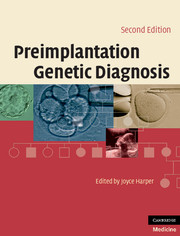Crossref Citations
This Book has been
cited by the following publications. This list is generated based on data provided by Crossref.
Simpson, Joe Leigh
2010.
Preimplantation genetic diagnosis at 20 years.
Prenatal Diagnosis,
Vol. 30,
Issue. 7,
p.
682.
2010.
In-Vitro Fertilization.
p.
216.
Ross, Sarah
2010.
Encyclopedia of Life Sciences.
Harper, Joyce
2010.
In-Vitro Fertilization.
p.
238.
Harper, Joyce C.
and
SenGupta, Sioban B.
2012.
Preimplantation genetic diagnosis: State of the ART 2011.
Human Genetics,
Vol. 131,
Issue. 2,
p.
175.
Simpson, Joe Leigh
2015.
Prenatal and Preimplantation Diagnosis.
p.
31.
Lu, Lina
Lv, Bo
Huang, Kevin
Xue, Zhigang
Zhu, Xianmin
and
Fan, Guoping
2016.
Recent advances in preimplantation genetic diagnosis and screening.
Journal of Assisted Reproduction and Genetics,
Vol. 33,
Issue. 9,
p.
1129.
Simpson, Joe Leigh
Kuliev, Anver
and
Rechitsky, Svetlana
2019.
Prenatal Diagnosis.
Vol. 1885,
Issue. ,
p.
23.
2019.
In-Vitro Fertilization.
p.
284.
2019.
In-Vitro Fertilization.
p.
311.
Simpson, Joe L.
and
Rechitsky, Svetlana
2020.
Preimplantation genetic testing to reduce preterm births in assisted reproductive technology.
International Journal of Gynecology & Obstetrics,
Vol. 150,
Issue. 1,
p.
34.
Al‐Kharusi, Khalsa
Bruwer, Zandre
and
Wessels, Tina‐Marié
2021.
The experience of Preimplantation Genetic Testing (PGT) among Muslim couples in Oman in the Middle East.
Journal of Genetic Counseling,
Vol. 30,
Issue. 1,
p.
121.



